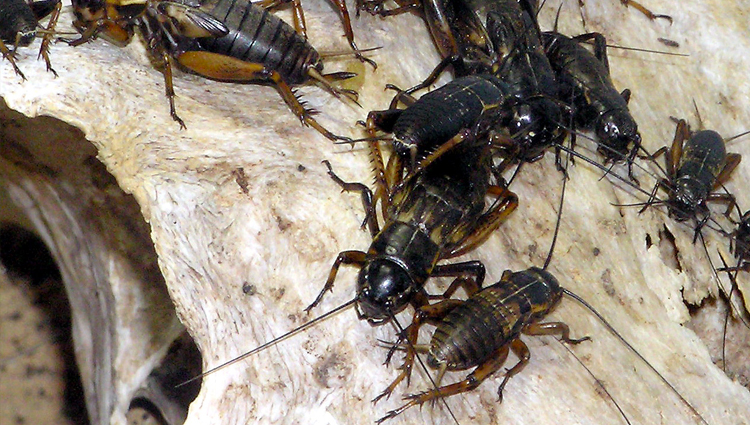Wild Nights For Crickets As Summer Kicks Off
Night vision cameras catch promiscuous backyard scenes that challenge sexual stereotypes.
Image

Media credits
WASHINGTON (ISNS) -- The next time you plan a quiet night listening to the chorus of crickets outside your window, keep in mind that you are eavesdropping on a cricket's wild night out -- a dating scene which, according to new research, challenges sexual stereotypes and has all of the fights, sex, and promiscuity of reality TV.
"They fight, they mate, they are quite similar to human beings," said Rolando Rodríguez-Munoz of the University of Exeter, U.K.
Over the past three years, Rodríguez-Munoz has watched more than 250,000 hours of cricket behavior on film at high speed, on four screens at a time.
This insect reality television show -- featuring a cast of 152 Gryllus campestris crickets on the prowl -- is the first experiment to monitor how they behave not in a lab but in their natural environment.
The up-close look at backyard evolution suggests that, evolutionarily speaking, females may get just as much of a benefit from sleeping around as males. And alpha males, the dominant warriors that come out on top in a fight, are not necessarily better at passing on their genes.
Crickets Gone Wild
Field crickets have short lives tied to the seasons. After hatching from eggs, they spend the winter in underground holes or burrows and molt in the spring to become adults. With at most a year to live, each cricket has one summer to reproduce.
Male and female insects spend that summer moving from burrow to burrow, looking for a willing mate.
"It's like suburban life seen at high speed," said Tom Tregenza, a co-author on the research project, which was published in this week's Science. "The obsession with the burrow, the keeping it clean, the going out at night and wife-swapping and fights, and so on."
To study this cricket community, the biologists set up 96 infrared cameras and microphones around a meadow in northern Spain. They glued tiny tags to the crickets to monitor their hookups and took small DNA samples to run paternity tests on the next generation of crickets born from these encounters.
Does promiscuity pay off?
The video and genetic analysis revealed that the females with the most partners also tended to leave behind the most offspring. This would not have been surprising in males, but in females it addresses a long-standing controversy over whether there is an evolutionary advantage to promiscuity for females, said William Wagner, who studies crickets at the University of Nebraska - Lincoln.
"This is something that has been suggested by some lab experiments," said Wagner. "But there are also lots of lab studies that suggests there might be no benefits to mating more frequently or even costs."
Biologists have long thought that females tend to be less promiscuous and more choosy than males because they must invest energy into creating an offspring -- the idea that sperm are cheap to make, but eggs are expensive. This view dates back to Charles Darwin, who described female creatures as "coy" and "less eager than the male". It's now called Bateman's principle, named after a biologist who found that male flies gain a greater benefit to having multiple partners than females and suggested that the same is true for people.
But accumulating evidence over the last decade suggests that this principle may not hold true for species as diverse as whales, rodents, and bees. Female prairie dogs with more mates tend to have larger litters. And monkey mothers may partner with many males to have more muscle to protect their offspring.
Previous cricket experiments by Tregenza suggested that females may mate with many partners to pick their best genetic match. An unusual ability to manipulate the sperm after it enters their bodies -- to flush out the undesirable -- could give them more options and help to avoid incest.
The new field experiment also revealed that there is no single formula for success among male crickets. Attractive crickets did not necessarily leave behind more offspring.
"There is more than one really good male," said Tregenza.
Dominant alpha males -- which can protect their mates from other males -- tended to move in and mate more often with one female.
Small crickets, incapable of fending off attack, showed their worth through song. They moved from burrow to burrow, spending less time with each female but finding more mates than their dominant counterparts and producing potentially just as many offspring.
A third category -- non-dominant but physically large, Schwarzenegger-like bugs -- attracted many mates and found reproductive success without much singing at all.
Despite this variety of strategies and choices, though, reproduction turned out to be a hard business for crickets. After the shenanigans were through, half of the females produced no surviving offspring at all. Males tended to be even more extremely divided between the majority losers who left nothing behind and the few big winners with large numbers of descendents.
So as sexy as their summer flings sound, most crickets still face a harsh reality. When the summer nights end, so do their genetic lines.
Filed under

